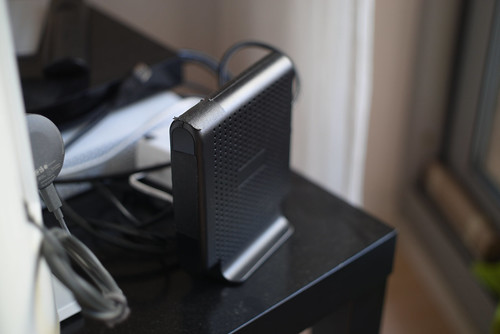Looking at a WiFi bridge we have in the apartment I could see the potential for looking at bit more at out of focus rendition in old Nikon Nikkor lenses. I could get out of focus dots and lines with no more effort than clicking the shutter.
Setup -
- Sony A6000 handheld
- Lenses using with a Lens Turbo II focal reducer -
- Nikon Nikkor-H 28mm f/3.5 pre-Ai
- Nikon Nikkor 28mm f/2.8 Ai
- Nikon Nikkor-O 35mm f/2 pre-Ai
- Nikon Nikkor 50mm f/1.8 AiS
- Nikon Nikkor-H 50mm f/2 pre-Ai
- Nikon Micro-Nikkor 55mm f/3.5 pre-Ai
- Nikon Nikkor-K 85mm f/1.8 K pre-Ai
- Nikon Nikkor 85mm f/2 Ai
- Nikon Nikkor-P 105mm f/2.5 pre-Ai
- Nikon Micro-Nikkor 105mm f/4 Ai
- NOTE1: Lenses were shot at their widest apertures only
- NOTE2: Out of focus samples are from points _behind_ the point of focus to compare background out of focus rendition
- RawTherapee to convert RAW files into black and white and to set the black levels
Here is the comparison setup. Pretty WiFi bridge, don't you think? More seriously, the top leading edge of the bridge is where I focused. As you can see, the body of the bridge goes out of focus.

If you click on the following image you can inspect it at 100 percent.

Comments -
NOTE: I feel the Lens Turbo II focal reducer adds a bit of under-corrected spherical aberration.
If there is a doughnut highlight outline around the edge of an out of focus dot or a stronger line along the edges of an out of focus line, the lens likely has over-corrected spherical aberrations behind the point of focus. Some people call this "soap bubble bokeh."
In this comparison I feel the following lenses exhibit noticeable over-corrected spherical aberrations behind the point of focus.
- Nikon Nikkor-H 28mm f/3.5 pre-Ai
- Nikon Nikkor-H 50mm f/2 pre-Ai
If a dot or line is smooth across the out of focus area, then the lens exhibits neutral spherical aberration correction.
In this comparison I feel the following lenses exhibit neutrally controlled spherical aberrations behind (and, of course, in front of) the point of focus.
- Nikon Micro-Nikkor-P 55mm f/3.5 pre-Ai
- Nikon Nikkor 85mm f/2 Ai
If a dot or line is brighter in the center of the out of focus area, then the lens exhibits under-corrected spherical aberrations. Nikon in their Thousand and One Nights series describes this as leading to a "delicate" out of focus rendition.
In this comparison I feel the following lenses exhibit noticeable under-corrected spherical aberrations behind the point of focus.
- Nikon Nikkor-H 28mm f/2.8 Ai
- Nikon Nikkor-O 35mm f/2 pre-Ai
- Nikon Nikkor 50mm f/1.8 AiS
- Nikon Nikkor-K 85mm f/1.8 pre-Ai
- Nikon Nikkor-P 105mm f/2.5 pre-Ai
- Nikon Micro-Nikkor 105mm f/4 Ai
Using this knowledge I can now match the "look" of images that I make. That is, if I want the Nikon described "delicate" out of focus rendition, I know which lenses to choose from. Similarly, since I don't like the "harshness" of over-corrected out of focus rendition, I know which lenses to avoid.
One last thing. I feel I should comment on the use of black and white for these comparisons.
Many of the lenses I looked at were designed during the era of black and white film. When looking at the color rendition, some of the lenses showed a bit of what I must interpret to be chromatic aberration. That is to say, the edge of out of focus areas are tinted/tinged with magenta on one side and green on the other. When shooting black and white film, this wasn't easily observable. But with the advent of color film, lens designers now had the opportunity to correct more lens faults in response to user demand for "better" lenses.
Here is an example of what I mean (with increased saturation and contrast to more strongly illustrate the effect).

Resources -
For further information on how the topic of out of focus rendition, optical properties, and Nikon lens design history, please refer to the following -
A PhD thesis on the impact of "soft focus" lenses on the history of photography - http://research-repository.st-andrews.ac.uk/handle/10023/505
An excellent starting point for understanding out of focus rendition (I might not completely agree with his interpretations/observations, but his foundation of understanding is quite good) - http://jtra.cz/stuff/essays/bokeh/
Nikon lens design histories - https://imaging.nikon.com/history/story/
Point light source discussions - https://www.dpreview.com/forums/thread/4031515
Zeiss comments on optical design - https://lenspire.zeiss.com/photo/en/article/how-does-zeiss-define-bokeh-an-interview-with-dr-stefan-ballmann
Metabones Focal Reducer whitepaper - https://www.metabones.com/assets/a/stories/Speed%20Booster%20White%20Paper.pdf